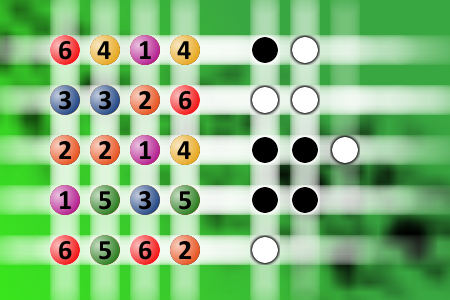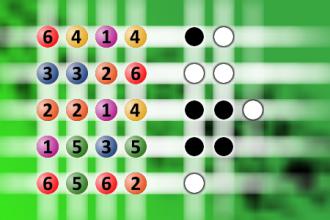What a winning combination?
The computer chose a secret code (sequence of 4 digits from 1 to 6). Your goal is to find that code. Black circles indicate the number of hits on the right spot. White circles indicate the number of hits on the wrong spot.Correct answers: 65
The first user who solved this task is Djordje Timotijevic.
#brainteasers #mastermind

Sister Mathematical and Sister Logical
Two nuns were walking home one night down a very dark street. One nun was called Sister Mathematical because of her gift for numbers and the other nun was called Sister Logical because of her gift for reasoning. They soon noticed that a man was following them. They would speed up, and he would speed up. They would stop, and he would stop. Sister Mathematical started to become afraid. "Oh dear...this man has been chasing us for 2.5 blocks now! What does he want?" "It's only logical," Sister Logical replied. "He wants to have his way with us." "Oh dear God!" Sister Mathematical exclaimed. They tried to move as fast as they could, but the man was gaining on them. "In 3.5 minutes, he will be upon us!" Sister Mathematical shrieked. "What do we do?" "Oh, that's logical," Sister Logical said calmly. "You and I will have to split up. You run one way to the convent, and I will join you there." Without asking another question, the nuns split up. Sister Mathematical, who could run faster, made it to the convent while the man took off after Sister Logical. A few minutes after Sister Mathematical arrived at the convent, Sister Logical entered. "Sister, I am so glad to see you," Sister Mathematical gasped. "It took you 7.6 minutes longer to get home. I was so worried! How in heaven's name did you escape?" "Oh that's logical," Sister Logical began, catching her breath. "He got to me and grabbed me. I knew what he wanted. So, I pulled up my habit." "Oh dear, Sister. Then what?" "He pulled down his pants....""Oh, Sister...!" Sister Mathematical exclaimed. "Then what happened?!" "Well, that's logical," Sister Logical explained. "A nun with her habit up can run a lot faster than a man with his pants down!"-

